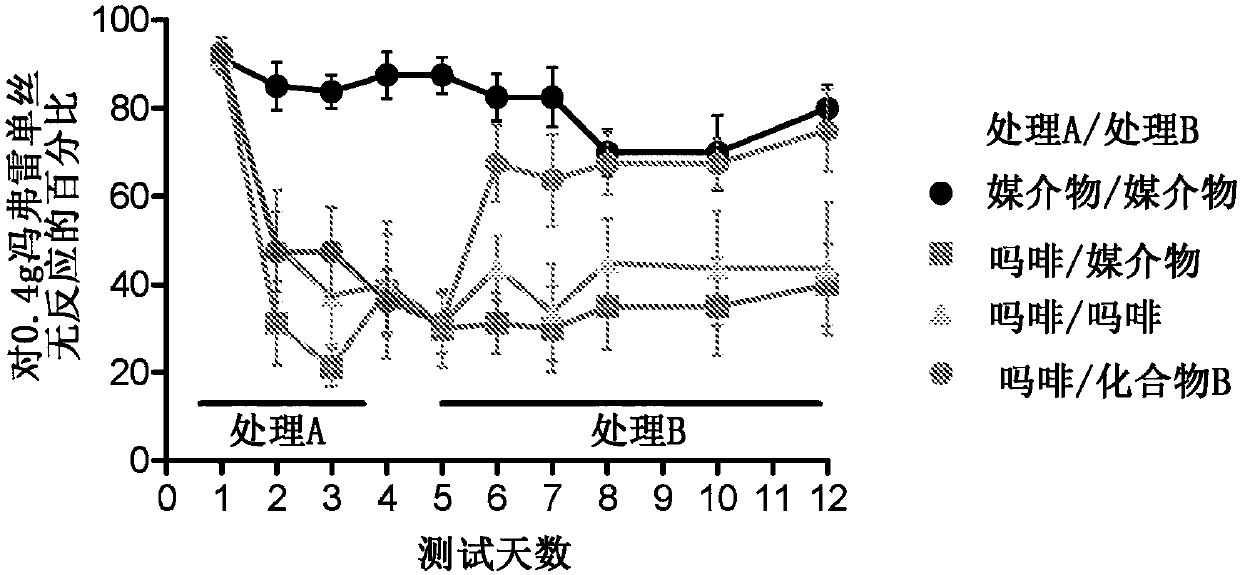Methods of treating hyperalgesia
A technology for hyperalgesia and subjects, which can be used in pharmaceutical formulations, medical preparations containing active ingredients, drug combinations, etc., and can solve problems such as hyperalgesia in patients
- Summary
- Abstract
- Description
- Claims
- Application Information
AI Technical Summary
Problems solved by technology
Method used
Image
Examples
Embodiment 1
[0244] Example 1: Biasing Ligands Do Not Induce Hyperalgesia Compounds were tested for their potential to induce hyperalgesia in a mouse model of opioid-induced hyperalgesia. In this test, mice (n=8 / group) were injected subcutaneously with vehicle or mu opioid agonist twice daily for 4 days. Measurements of mechanical hyperalgesia were obtained using repeated stimulation with a single von Frey monofilament (0.4 g) on each of the four drug treatment days. On the fifth day, the animals were tested again without additional drug treatment. For testing, a monofilament is applied to the hind paw for approximately 1-2 seconds. If there is a withdrawn response, it is recorded as a positive response. Each mouse was repeated ten times. The final measurement for each mouse was the percentage non-response to the stimulus out of ten trials. The result is as figure 1 shown. Compound A is Compound 265 and Compound B is Compound 54.
[0245] Graph shows the percentage of non-response...
Embodiment 2
[0247] Example 2: Biased Ligands Reverse Opioid-Induced Hyperalgesia Compounds were tested for their potential to reverse opioid-induced hyperalgesia in a mouse model of opioid-induced hyperalgesia. In this test, mice (n=8 / group) were injected subcutaneously with vehicle or reference mu opioid agonist twice daily for 4 days. Measurements of mechanical hyperalgesia were obtained using repeated stimulation with a single von Frey monofilament (0.4 g) on each of the four drug treatment days. Animals already receiving the reference mu opioid agonist were switched to compound B after behavioral testing on day five. Subcutaneous injections were continued twice daily until day 12. Behavioral assessments of mechanical allodynia were performed on days 5, 6, 7, 8, 10, and 12. For testing, a monofilament is applied to the hind paw for approximately 1-2 seconds. If there is a withdrawn response, it is recorded as a positive response. Each mouse was repeated ten times. The final meas...
Embodiment 3
[0248] Example 3: Human subjects prescribed morphine exhibit symptoms of opioid-induced hyperalgesia. Subjects discontinued morphine and administered Compound 140 or Compound 265. Treat and reduce opioid-induced hyperalgesia in a subject. Subjects continued to take Compound 140 or Compound 265 and did not suffer from hyperalgesia while maintaining pain relief.
PUM
 Login to View More
Login to View More Abstract
Description
Claims
Application Information
 Login to View More
Login to View More - R&D
- Intellectual Property
- Life Sciences
- Materials
- Tech Scout
- Unparalleled Data Quality
- Higher Quality Content
- 60% Fewer Hallucinations
Browse by: Latest US Patents, China's latest patents, Technical Efficacy Thesaurus, Application Domain, Technology Topic, Popular Technical Reports.
© 2025 PatSnap. All rights reserved.Legal|Privacy policy|Modern Slavery Act Transparency Statement|Sitemap|About US| Contact US: help@patsnap.com



